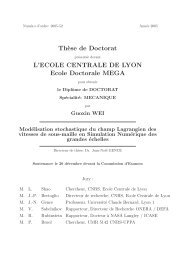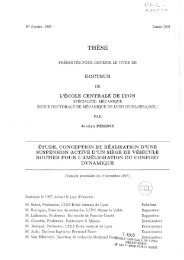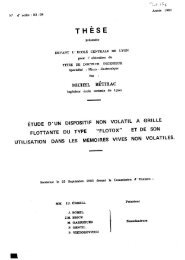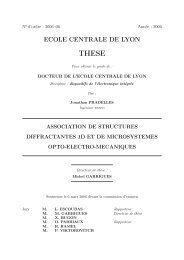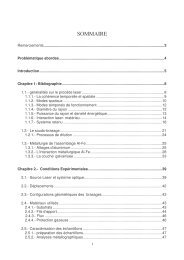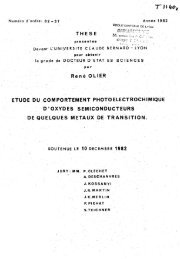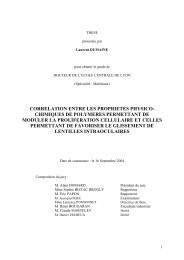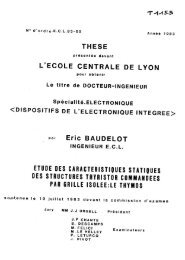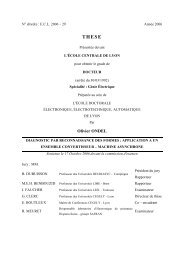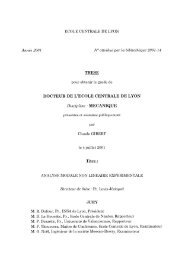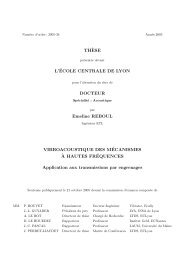MR thèse 2006-21 - Bibliothèque Ecole Centrale Lyon
MR thèse 2006-21 - Bibliothèque Ecole Centrale Lyon
MR thèse 2006-21 - Bibliothèque Ecole Centrale Lyon
Create successful ePaper yourself
Turn your PDF publications into a flip-book with our unique Google optimized e-Paper software.
Chapitre IV – Les Protagonistes de la Détergence<br />
Les moindres performances des formulations nettoyantes/pré-désinfectantes sont la conséquence d’un<br />
antagonisme entre les mécanismes de la détergence et ceux de la désinfection. Les principes actifs<br />
antimicrobiens doivent leurs activités biocides à leurs propriétés physico-chimiques qui leur confèrent<br />
une forte capacité d’interaction avec les microorganismes. Cependant, ces interactions n’étant pas<br />
spécifiques aux microorganismes, les principes actifs antimicrobiens peuvent également s’adsorber sur les<br />
salissures organiques et compromettre l’action détersive des tensioactifs et des enzymes. Il est donc<br />
préférable d’avoir recours aux formulations nettoyantes/pré-désinfectantes après que les matériaux aient<br />
été préalablement nettoyés. Dans ce contexte, la mise en place du double nettoyage se trouve parfaitement<br />
justifiée.<br />
IV. REFERENCES<br />
ALLEN, M.J., MORBY, A.P. and WHITE, G.F. (2004). Cooperativity in the binding of the cationic<br />
biocide polyhexamethylene biguanide to nucleic acids. Biochemal and Biophysical Research<br />
Communications. 318: 394-404<br />
BAIER, M., SCHWARZ, A. and MIELKE, M. (2004). Activity of an alkaline 'cleaner' in the inactivation of<br />
the scrapie agent. Journal of Hospital Infection. 57: 80-4<br />
DEEP, S. and AHLUWALIA, J.C. (2001). Interaction of bovine serum albumin with anionic surfactants.<br />
Physical Chemistry Chemical Physics. 3: 4583-4591<br />
DURCHSCHLAG, H., TIEFENBACH, K.J., WEBER, R., KUCHENMÜLLER, B. and JAENICKE, R. (2000).<br />
Comparative investigations of the molecular properties of detergents and protein-detergent complexes.<br />
Colloid and Polymer Science. 278: 312-320<br />
FICHET, G., COMOY, E., DUVAL, C., ANTLOGA, K., DEHEN, C., CHARBONNIER, A., MCDONNELL, G.,<br />
BROWN, P., LASMEZAS, C.I. and DESLYS, J.P. (2004). Novel methods for disinfection of prioncontaminated<br />
medical devices. Lancet. 364: 5<strong>21</strong>-6<br />
GILBERT, P. and MOORE, L.E. (2005). Cationic antiseptics: diversity of action under a common epithet.<br />
Journal of Applied Microbiology. 99: 703-705<br />
JACKSON, G.S., HOSSZU, L.L., POWER, A., HILL, A.F., KENNEY, J., SAIBIL, H., CRAVEN, C.J.,<br />
WALTHO, J.P., CLARKE, A.R. and COLLINGE, J. (1999). Reversible conversion of monomeric human<br />
prion protein between native and fibrilogenic conformations. Science. 283: 1935-7<br />
KASERMANN, F. and KEMPF, C. (2003). Sodium hydroxide renders the prion protein PrPSc sensitive to<br />
proteinase K. Journal of General Virology. 84: 3173-6<br />
LANGEVELD, J.P., WANG, J.J., VAN DE WIEL, D.F., SHIH, G.C., GARSSEN, G.J., BOSSERS, A. and<br />
SHIH, J.C. (2003). Enzymatic degradation of prion protein in brain stem from infected cattle and sheep.<br />
Journal of Infectious Disease. 188: 1782-9<br />
LEMMER, K., MIELKE, M., PAULI, G. and BEEKES, M. (2004). Decontamination of surgical instruments<br />
from prion proteins: in vitro studies on the detachment, destabilization and degradation of PrPSc bound to<br />
steel surfaces. Journal of General Virology. 85: 3805-16<br />
MCLEOD, A.H., MURDOCH, H., DICKINSON, J., DENNIS, M.J., HALL, G.A., BUSWELL, C.M., CARR, J.,<br />
TAYLOR, D.M., SUTTON, J.M. and RAVEN, N.D. (2004). Proteolytic inactivation of the bovine<br />
spongiform encephalopathy agent. Biochemal and Biophysical Research Communications. 317: 1165-70<br />
ROSENBERG, N. and GERVAIS, P. (1987). Rhinite et asthme professionnels aux enzymes. Documents<br />
pour le médecin du travail. 29: 1-4<br />
- 1<strong>21</strong> -



